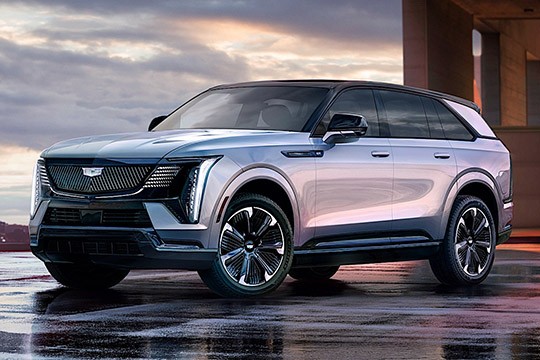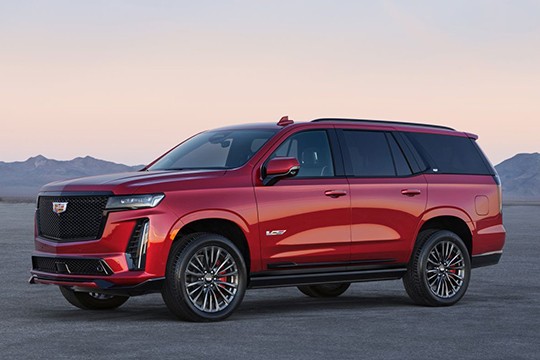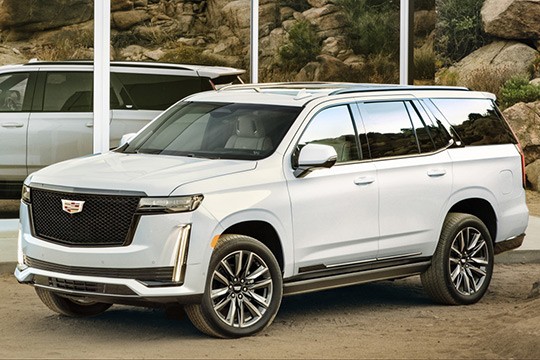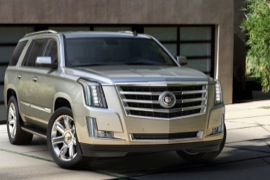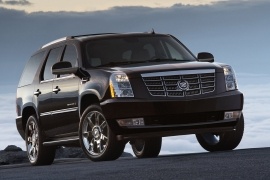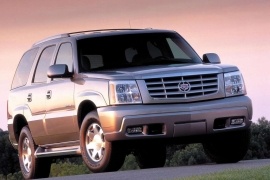CADILLAC Escalade Models/Series Timeline, Specifications & Photos
First production year: 2000
Engines: Electric, Gasoline, Diesel
Body style: SUV (Sports Utility Vehicle)
General Motors stepped up its game and introduced the Escalade IQ in 2023 as part of the electric-car revolution. Since it already had the advanced Ultium platform that was already used on the Chevrolet Silverado EV, the automaker thought that it would be a great idea to use it on the luxurious Escalade and added the IQ badge behind that famous nameplate.
Since the Escalade was considered the luxury brand's flagship, it just came naturally for the American brand to burn the midnight oil and provide customers with an exquisite experience. Besides the technology and the luxury features of the vehicle, the Escalade IQ had to be bold-looking and provide a demanding look on the road.
The SUV featured a front fascia adorned with LED headlights that surrounded the main V-shaped panel where the badge took center stage. On the sides, the vertically-mounted daytime running lights clearly defined the vehicle's edges. From its profile, the Escalade IQ has shown tall door panels that cover one-third of the car's height. Behind the rear doors, the raked-forward C-pillars and the wrap-around rear windscreen created a dynamic look for the full-size American SUV.
Inside, Cadillac installed a luxurious cabin with up to six leather-wrapped seats. On the dashboard, the Escalade IQ boasted a wide curved display that covered the entire area between the A-pillars. Fronting the driver was the instrument panel, followed by the infotainment units' display atop the center stack. In addition, a separate touchscreen hosted the controls for the HVAC system. Furthermore, the side passenger had it own big display that controlled some of the audio.
One of the IQ's advantages was the front storage compartment that was large enough to fit two sets of golf clubs. In addition, at the back, the trunk's maximum space could reach a staggering 119.2 cu-ft (3,375 liters).
Cadillac adjusted the Ultium platform to provide a comfortable ride for its customers. As a result, the pneumatic, adaptive suspension and the battery pack could provide a smooth ride, and the driver could've lowered the ground clearance by 2 inches (50 mm) for easy access or raised it by 1 inch (25 mm) for crossing over obstacles. Despite the SUV's mass, the Escalade IQ offered up to 680 HP (500 kW) to please its customers. The battery pack fitted inside the vehicle's floor was large enough to hold up to 200 kWh of juice.
Last but not least, Cadillac thought about the SUV's maneuverability. Besides the all-wheel drive system, the Escalade IQ also featured a system named Four-Wheel Steer that could lower the turning radius to 39.4 feet (12 meters), comparable to compact-sized vehicles. In addition, the same system could've been used to move the car diagonally, thus easing entering and exiting parking spots.
Cadillac finally introduced a V-version for its much-acclaimed Escalade range and entered the competition in the performance-SUV segment with its biggest rig on the roads.
While it was not meant to challenge vehicles such as Porsche Cayenne Turbo or the Mercedes-AMG SUVs in terms of handling performances, the Cadillac Escalade-V offered a more luxurious presence backed up by comfort and convenience features. The carmaker aimed more at its local competitors, such as the Grand Wagoneer from Jeep and the Lincoln Navigator.
In terms of styling, the big SUV revealed a blacked-out grille instead of the chromed one installed on the rest of the range. A pair of vertically-mounted air-scoops hosted the LED daytime running lights while in charge of expanding the cooling capacity was a lower grille placed in the front bumper.
The angular, muscular lines of the vehicle were emphasized by the black side sills and big light-alloy wheels. In addition, the blacked-out B-, C-, and D-pillars created the sensation of a floating roof design. At the back, a quad-exhaust with rectangular tips flanked a useless diffuser placed under the bumper. Its roof-spoiler was there mostly to keep the rear window cleaner for longer than for downforce performance.
Like its non-V version, the Caddy-V came with independent suspension in all corners backed up by an adaptive suspension that increased the comfort or handling, depending on the driver's preferences.
The Cadillac Escalade nameplate was first marketed in 1999 and was designed to directly challenge the Lexus LX and Ford's Lincoln Navigator. The latest Escalade comes with two engine versions, the first being the diesel that develops 277 hp, with 460 lb-ft of torque and the second one gasoline, with a V8 engine that develops a whopping 420 hp and 460 lb-ft of torque. Both are paired with a 10-speed automatic.
The mesmerizing evolution of the big luxury SUV has come to its peak through the latest model, as it reflects a fluid combination between tradition and technology. Some of the highlighted strengths added in this interpretation are the innovative 38-inch curved screen for the front passengers, an augmented reality-enabled navigation (which uses live street views with directional overlays) and two 12.6 inch independent touch displays at the rear, with navigation as well as streaming capability to play games, music and videos through HDMI and USB inputs.
The Cadillac Escalade is more spacious than before, with up to 40 percent more third-row legroom and a 68 percent boost in maximum cargo space behind the third row, in the standard version. The model stands true to its DNA through the brand's signature vertical lighting element with a new complementary horizontal headlamp for a more confident look.
The fourth generation of the Escalade was unveiled in 2013 in New York, but the production started in January 2014. It was the most expected luxury car of the year in the U.S.
The 2015 model of the Escalade was another luxury vehicle built on top of a pickup truck chassis. The body-on-frame structure was a normal requirement for the American customers, who didn't care too much about the unibody constructions for large luxury vehicles.
On the outside, despite being very big, the Escalade featured a big, chromed, grille with vertical, angular, headlights. An LED daytime running light was continued from within the headlights to the lower fog-lights. From the side, there was the same design idea from its predecessor, with body-colored A and C-pillars, and darkened B- and D-pillars. Like its predecessors, it was available in short or long wheelbase.
Inside, the Escalade followed the design lines introduced by its smaller brothers and offered expensive materials and advanced technologies. The automatic braking, and the lane keep assist systems were part of the safety package. The infotainment unit mounted high on the center stack featured a standard 12.3” touch-screen and it was Android Auto and Apple CarPlay compatible.
The only engine available was a 6.2-liter V8 with direct injection technology and cylinder deactivation. It was mated as standard with a 6-speed automatic. The Escalade was available with 2WD or 4WD and the rear locking differential was standard.
Introduced for the first time in 1999, the Escalade was not very promising. While great luxury was offered, the Escalate was not that different from the Chevy Tahoe.
With its second generation launched in 2002, the Escalade became one of the most popular SUVs on the market.
If in the past, the engine mounted on the Escalate was a bit underpowered, the new 2006 generation surprised the public with a 345 hp V8 powerplant that satisfied the needs of power-hungry customers.
The Escalade offered seating for 7 and that should be of no surprise as it was a full-size luxury SUV.
A single trim level was available and the standard features included a tori-zone climate control, leather upholstery, a Bose audio system and others. Standalone options included bigger 20-inch chrome wheels and a second-row bench instead of the bucket seats to increase its versatility by accommodating 8 passengers.
Both two-wheel-drive and a four-wheel-drive systems were available, coming with the standard 6.0-liter V8 we already mentioned.
Safety wise, standard stability control, four-wheel antilock disc brakes and side airbags were included. Tested for frontal impacts, the Escalade managed to score 4 stars out of 5.
Inside the Escalade’s cabin, the driver and passengers would’ve bathed into luxury with the multitude of soft leather surfaces along with shiny wood accents.
The Escalade was one of the most notorious luxury SUV on the American market. It was promoted by rap-singers and celebrities as well. And it was an official car for the White House.
Europeans had the Mercedes-Benz as one of the top premium brands. Cadillac, on the other hand, had the same premium image on the American market. While the first-generation was most of a re-badged GMC Yukon Denali, the second generation featured a completely new front side, which made it different than the other cars on the market.
It was the struggle to keep its advance on a market that switched very fast from the MPV to the SUV segment in just a few years. The 2000 model was introduced just two years after the model series was launched, and that was unusual. The big, angular, headlights were a feature that started the edge-design era for the Cadillac. Even if the sidelines still resembled the GMC, the new front fascia and the taillights were different. But the flared arches on the rear quarter panels were the same.
Inside, the Escalade offered room as any MPV on the market. It was fitted as standard with 7 seats. The leather upholstery was a standard feature for all trim levels. The complex, eight-dial instrument cluster was cluttered and raised some eyebrows from its customers. If that wasn't enough, an additional clock was mounted lower on the center stack, next to the climate control unit.
Since it had to compete with Mercedes-Benz ML and Lincoln Navigator, the Escalade was fitted with a choice of two engines. Both were V8 and paired to a 4-speed automatic, unlike the Mercedes-Benz who offered a 5-speed auto.
